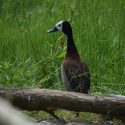
White-faced Whistling Duck Natural History
Size
They can reach a height of up to 40cm and they can weigh up to 900g.
Habitat and Distribution
These birds can be found in freshwater marshes and lakes in sub-Saharan Africa, much of South America and parts of the Caribbean and central America.
Age
The average lifespan of these birds is between 10-15 years.
Diet
The White-faced Whistling Ducks typically feed on grass, seeds and aquatic molluscs.
Groups and Breeding
Their breeding season begins at the start of the rainy season. A clutch of eggs can have up to 13 eggs in and they have within a month. Once the breeding period has ended, the adults undergo a brief flightless moult period. The chicks leave the nest and fledge 8 weeks after hatching.
Threats
Some threats these ducks face include avian disease, hunting and habitat loss. The IUCN Red List classes the White-faced Whistling Ducks as Least Concern.
Interesting Facts
As their name implies, they have a high-pitched whistle for a call. These ducks also perch on branches in trees and are also known as Tree Ducks.
The White-faced Whistling Ducks During Your Day Out in Kent
Our White-faced Whistling Ducks can be found opposite the diggers near the play area. They are housed next to our Ringed Teals, Red Handed Tamarins and Common Marmosets.